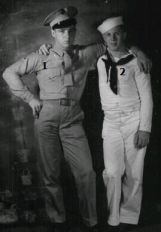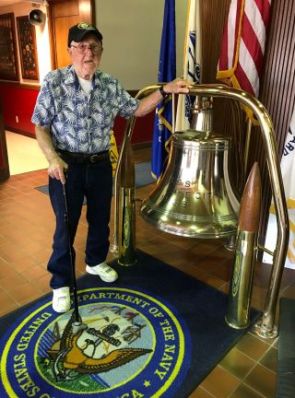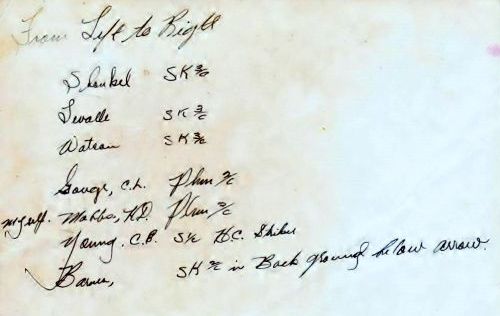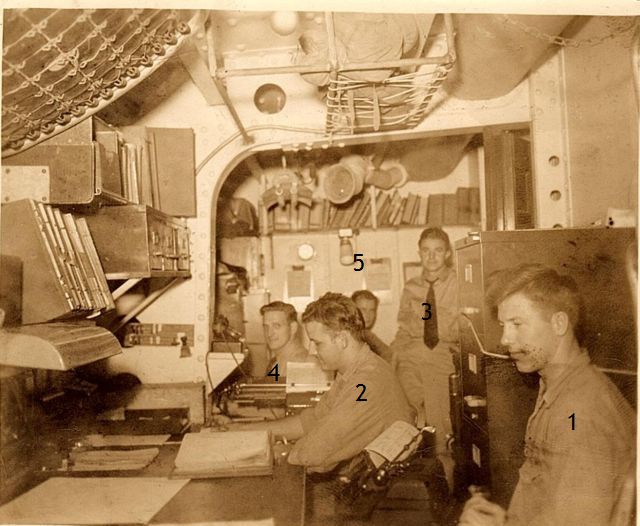USS SLC...Enlisted Navy...Vere Gardner, SKD1c
 Vere Gardner passed away on Mar. 2nd, 2019. He was surrounded by family & friends as he peacefully
passed while they sang hymns. We love him & he will be missed. Burial in Gridley, CA. with full
Military honors. Information from daughter, Sharon Gardner Miller
Vere Gardner passed away on Mar. 2nd, 2019. He was surrounded by family & friends as he peacefully
passed while they sang hymns. We love him & he will be missed. Burial in Gridley, CA. with full
Military honors. Information from daughter, Sharon Gardner Miller
Jan. 24th, 2001
#10 in picture with Storekeepers, 1944-45
#4 in picture with Sight Setters
SLC Deck Log, Dec. 1941
1995 SLC Reunion
Signatures in Autograph Book Page 02
Signatures in Autograph Book Page 03
First of all, I wanted to thank you for maintaining such a great
historical reference in this website. My wife's grandfather, Vere
Gardner, served on the USS Salt Lake City from 1940-1945 as a
sight setter on an anti-aircraft gun. He worked in the pay office &
gave the crew their "pay". I am trying to contact
my mother-in-law so we can get more of his information posted on the site.
About eight months ago, I discovered your site, and began a project
of trying to learn more about a period of history in my wife's
grandfather's life. I am a World War II history buff, and a graphic
artist as well, and after researching the USS Salt Lake City, I
decided to use the US Navy's plans of the ship to recreate it in a
high resolution graphics file. Recently I finished my project.
Here is my drawing of the USS Salt
Lake City, exact in every detail of the blueprints I received.
Thanks again for the information on this site. It has meant a lot to me
to experience as best I can an important period in my country's and my
family history.
Sincerely,
Arkin & Jenny Hill
West Jordan, Utah
Information from Vere Gardner
“I went into the Navy in November, 1940 after graduating from High School. I volunteered to go. I was inducted at Goat Island.[ San Francisco, California]. It was next to Treasure Island [He rode on the ferry]. I went aboard U.S.S. Salt Lake City [a heavy cruiser] in February at Mare Island Ship Yard.[ without any formal navy boot camp training] I had to learn everything the hard way ha! [ He scrubbed the deck and worked in the ships store .] I never got sea sick, if I was careful ha! ha! We went to Pearl Harbour after our shakedown [overhaul ] to Long Beach [California]. We had lots of training, hard work to get ourselves and the ship back in shape after a complete overhaul.
[Somewhere about this time, he first crossed the equator and had an initiation to become a member of Neptune Order, a old tradition for sailors. They also visited Borneo and had natives visit the ship for a party.]
It was here that I got to know Rex Reno [a marine from Aberdeen, Washington], who became a long time friend, and [I] joined the ships wrestling team. Our coach was an all Navy wrestler who wrestled under another name as a professional. There weren't many people who could pin him. I learned a whole lot from that experience. I won 1 st. place in lightweight division.
I got to see a lot of the island [Hawaii]. Whenever I got to go on liberty, I went to different wards all over the island. I usually went ashore by myself, because I didn't drink and that was the main attraction for the servicemen. I ran across a cousin of mine [Lyle Merritt] from Utah in the army at Fort Rucker. He lived off the base, so I ended up there on a long weekend. Sometimes we went to a dance. What little I know about dancing, I learned from his friends and their girl friends. Ha!
In late June or early July we [ U.S.S. Salt Lake City] and Crdiv 5 and 8 Destroyers left Pearl on a hush trip to the south pacific. On the way we picked up 5 Dutch merchant ships. We were told to load our guns and stand by to fire on anything that came in our way. On board the merchant ships was a member of the Dutch Royal Family going to the Dutch East Indies. Also the ships were all loaded with war supplies for their army over there. After taking them there, we went to Brisbane, Queensland, Australia. We had a big [welcome] parade and a state dinner afterwards. That is where Rex and I got to know the Albrecht's, Rex's future wife [Thoreen Albrecht]. We only stayed three days. From that time that we left Pearl Harbour all our mail was censored, unofficially we were at war! We would not tell anyone where we was or where we had been.
We came back to Pearl for some minor refittings and then out to target practice. This is when I got to stay in Pearl to work on the boats.
The ship would be out for a short time, then tie up for about two weeks to clean up and do
some much needed painting. Ha! But instead after target practice one day they escorted
two carriers, Enterprise and Hornet, with Marine aircraft for Wake Island. When they
returned, 7 a.m. Dec. 7, 1941, they was turned back outside Pearl by torpedo attack and
had to wait until later to come in and fuel up and go right back out again. It was three
days before they returned and I again was able to go back on board.
December 7, 1941 8 a.m. Marine barracks mess hall
While I was with the boat crew, I had to take my turn at mess cooking, [ He had
been peeling potatoes] when the Jap planes came over on the first run at the battle wagons
alongside of Ford Island. I witnesses the Marine lst Sgt. shoot off the lock on the
armory to set up machine gun to fire on planes, shortly there was a report of parachutes
in the sky, so everyone was issued a rifle and ammo and loaded into trucks and taken in a
peramiter around Pearl Harbor. I was unloaded along with a marine corporal in a housing
out of the submarine base, where a off-duty officer was taking moving pictures. Our
position was on a rise and could see everything that was happening in the harbor. When
the planes made their runs on the ships they had to make a wide turn to go back to attack
again, and they flew right over where we stood. Both of us, corporal and I, would fire
our rifles at the planes, soon one of the planes exploded. So we shot down a plane. We
never got credit for it because they never found the wreckage. It was found in the 1980's
and our names are on a plack in Pearl Harbor. It didn't make any difference to me, I
knew that I had done what I could."
Later, after the parachute scare was over, the recalled guards and I was assigned as guards on big UK truck to go out to a sugar factory to pick up sugar sacks for sandbagging.
That night I was assigned in a jeep to patrol streets of Honolulu to make sure that there were no lights. While on patrol, someone turn on the lights in a barber shop. In less that 10 seconds, all lights and mirrors was shot out-- but good.
Next morning, 7a.m., submarine base, civilian workers arranged to go to work. I was assigned to help inspect every vehicle that entered. I mean we really tore every vehicle apart if they even looked like they were Japs.
It was three days before the ship came in to change from peace time to war time ammo. In just a very few hours we completely removed thousands of round 8 in 5 in target rounds and put on AA and Armor piercing round. We hurried back out to sea, because we did not want to be caught inside if the Japs came back. [His first job after Pearl Harbor was look out in the crows nest watching for submarines. He had better than 20/20 vision and was selected for the task. (Interview May 2001).]
We had the privilege of the first offensive attack against the Japs, 1 February 1942. We bombarded the island of Wotje in the Marshall Islands group. It was the first of 9 times that we hit it, but the first time we didn't know what to expect? Planes or support ships????? We was at G.Q. [general quarters- standing at battle stations] for 72 hours, during which time my hair showed grey. We lived , ate, and slept on our battle stations, rain or shine, night or day.
24 February we hit Wake Island
02-12 August 1942 we hit Kiska Island
04 March 1942 Marcus Island
April Doolittle Tokyo Raid [The U.S.S. Salt Lake City was part of support group for the Doolittle Tokyo Raid and became the first to fire on Tokyo before any of the other ships. It seems they literally “jumped the gun”. Read more about the Doolittle Raiders
“I watched Doolittle as he and the others took off”[Interview, May 2001]
August 1942 Guadalcanal Landing
The battle of the Coral Sea where the Carrier WASP was sunk, the torpedo that sunk her passed right underneath the U.S.S. Salt Lake City. When we seen the wakes, we thought we had had it, but they was too deep for us. Ha! [The U.S.S. Salt Lake City was a merchant marine ship commissioned in the 1929. It had to be converted to a heavy cruiser and had a unique flaw that caused the whole ship to bow thus the nickname of “old Sway back”. This flaw saved them from many a torpedo and one of the reasons it was the most reported sunk ship by the Japanese during the war.]
11 August, 1942 Battle of Savo Island
Up to this time I was the sight setter and talker on 5 in AA gun #5 on starboard side of the ship, just back of the after smoke stack. The battle happened while supporting the marines landing on Guadalcanal. The nip would come down the slot [a strait of water between two land masses] almost every time. So our force laid a trap for them and caught them as they crossed the "T". [ A place where two straits came together] This happened about 1 a.m. and when we turned the searchlight on them it looked like the whole sea was like a large harbour [full of ships]. When we finally got the score we [U.S.S. Salt Lake City] had sunk 2 heavy cruisers, 1 light cruiser and 1 destroyer also 1 merchant ship.
It was in this action that I had one of my closest brushes with death, if I had been standing in my regular place on my gun I would have been hit in the middle of my back with or by a piece of shrapnel [metal debris]. Then we were hit by a Japanese shell which had hit the smoke stack and [shrapnel] passed right between my legs. I had moved up on the railing on the guard rail to see the action on the port side of the ship to tell the others of the gun crew what was happening. Like, our first salvo [a big shell] hit the heavy cruiser at the water line and rolled over, next salvo hit the keel and the ship literally broke in half.
The second time that I had a near miss was in the same action that [his marine friend] Rex Reno took shrapnel in his stomach. He was up on a machine gun above the bridge of the ship. When we was hit by shrapnel off Kwajalein, a dive bomber crashed along side of the ship and blew up, which sent shrapnel which hit our [observation] airplane. So we had to go down to push the damaged aircraft off the ship. I was the third one down the ladder and 4th one down was hit in the head as he started down [and died]. It was just 4 feet from my head. He was one of the twins that was aboard ship. [During the five years he was aboard ship, U.S.S. Salt Lake City only lost 10 men.(Interview May 2001and website).]
In March of 1943 we were in the longest sea battle of the war, off the Komandorfskis Islands [Now know as the Commander Islands]. We were covering the retaking of the Aleution Islands off Alaska. We also experienced the worst storm we'd ever been in. The ship was turned on it's side at 45 degree angle. Men were being tossed to and fro. Arms and ribs and legs were being broken. It was awful. [One of the ten men who died during the war was washed overboard in this storm.] Later we ran into a larger force of nips. We had 1 heavy cruiser, 1 light cruiser, 5 destroyers. They had 2 heavy cruisers, 3 light cruisers, 8 destroyers. We had to run towards Japan and Russia to stay out of harms way. Right off they hit our fire control. So all that we could do was fire by local control, by our eyesight, only. Even at that we severely damaged both their heavy cruisers and 2 light cruisers. Finally they hit us below the waterline in the fuel oil tank and we went dead in the water then the fire in the foilers went out. Our destroyers laid down a smoke screen to protect us and then proceeded to make torpedo attack on the enemy ships. The only time in the war was this ever done. It was very scary to see the enemy ships fire and watch the Captain of our ship maneuver out of the way and watch the shells land right where we had been before.
We covered the landings of the following islands and beaches in the Pacific: Guadalcanal, Kiska, Kwajalein, Majuro, Saipan, Leyte Gulf, Iwo Jima, Okinawa, Phillippine Islands. [The U.S.S. Salt Lake City was in 38 major engagements.] At this time I left the ship to come home to marry Artie 30 days before the war was over.
I was at Iwo Jima when Uncle Rusty Ford was wounded. Also I was on duty up in the foremast, with the gunnery officer and I watched the marines put out the flags on Mt. Surabatchi. We had to get as close as we could be to the beach to cover the marines in their advance positions. We would be talking to F.O. and firing 8 in shells as close as 100 yards in front of the line. There were so many caves in the rocky formation that the only way to reach them was to blast them out or use flame throwers, if you could get close enough. SLC covered the whole battle of Iwo Jima without relief [from another ship].
Okinawa was much the same except we had to watch out for kamikasi airplanes as well as do all of our other bombardment duties. We never were hit by a kamakasi but I have seen other ships all around us that were not so fortunate. Ask Richard McDowell [a neighbor], he was on a destroyer picket ship about 100 miles closer to Japan than we were. Also during this operation we had to fire every day for the entire operation. We were the only one to do this. Also we had to find some way to get ammo on board so we could shoot # 1's.
Our ship developed a system to transfer ammo directly from the ammo ship at sea, no easy task.
[ Interview, May 2002, Dad adds other items of interest.]
[While on board ship, every evening they would make ice cream. They used powdered milk which gave it an awful taste. So they would mask the flavor with chocolate.
Also there was a time, a week I believe, that the ship had run low on food. There weren’t any safe ports to pull into. He remembers eating food with live maggots in it. They were protein. They didn’t worry about running out of water. For they were able to convert sea water to drinking water.
It was very, very hot aboard ship. Usually, in afternoon they had liberty to go swimming. There were always at least two look outs with rifles to shoot any sharks that came too close. Some of the crew even caught a shark and brought it aboard. He liked to dive off the side of the ship. He was a good swimmer and until a few years ago could swim three lengths of an Olympic pool underwater. The Captain even had a sail boat that he would use from time to time.
There were 7 members of the L. D .S. Church on board his ship. They didn’t hold services. If there was an air craft carrier in port, they went there for church. The air craft carrier had many more servicemen on them than a cruiser and usually, more members of the church.
The only time he saw any of the enemy was when they brought some prisoners of war on board ship to transport to a P.O.W. camp. There were just a few in number.]
“ The USS Salt Lake City was the most reported ship sunk by the Japanese. Of course, it wasn't but had some close calls. In the 50's it was used as a target practice ship and was sunk. [It took many times before it was sunk. A modern submarine now carries her name.]
USS Salt Lake City CA25 Battle History: (sunk)
Heavy Cruisers 4
Merchant ships ll
Airplanes 12
Islands Hit 30
Major Engagements 38
My jobs: [scrub the deck, storekeeper, look out, sighter,] gunner, radio operator, and ships clerk and payroll.
[ When the ship came into port he would go on shore to pick up all the payroll for the ship. Just him alone with a side arm pistol and a sachel full of "millions of dollars”. (Interview May, 2001)]
Married Artie Mae Sutton, 15 July 1945, in Gridley, California, in my parents home on Richen Road , 2 p.m. by Stake Pres. John Todd. Honeymooned in Long Beach at brothers Don Gardner and wife Carol cottage. Also my sister Faith was there visiting. Did not get out of service until Jan 1946 because I had an Essential rating. I had to help discharge officers and payroll.”[Out-processing was done in Hawthorne, Nevada.]
Compiled by daughter
Sharon Gardner Miller
© 2003 Sharon L. Miller, All Rights Reserved

 Vere Gardner passed away on Mar. 2nd, 2019. He was surrounded by family & friends as he peacefully
passed while they sang hymns. We love him & he will be missed. Burial in Gridley, CA. with full
Military honors. Information from daughter, Sharon Gardner Miller
Vere Gardner passed away on Mar. 2nd, 2019. He was surrounded by family & friends as he peacefully
passed while they sang hymns. We love him & he will be missed. Burial in Gridley, CA. with full
Military honors. Information from daughter, Sharon Gardner Miller




